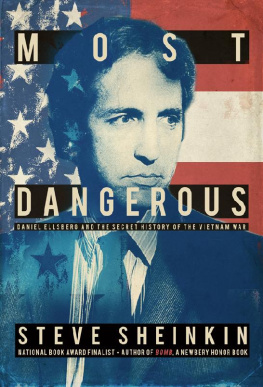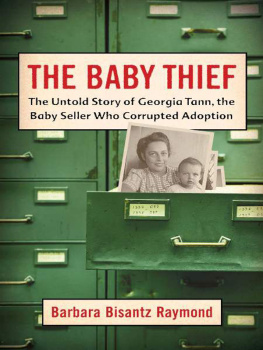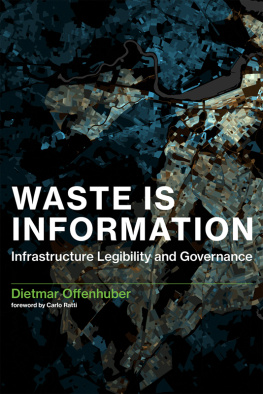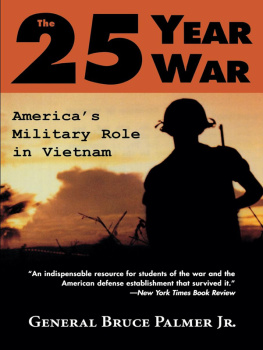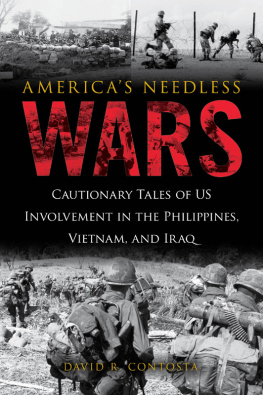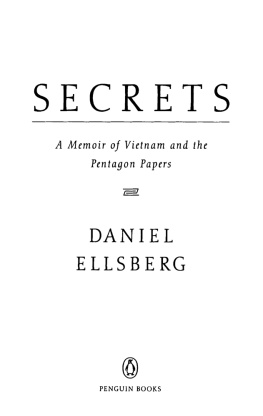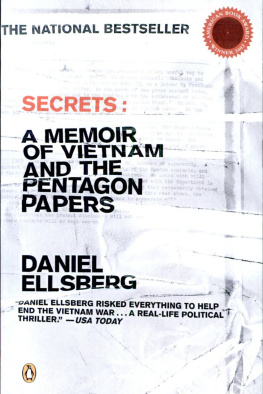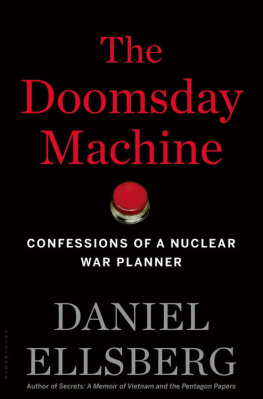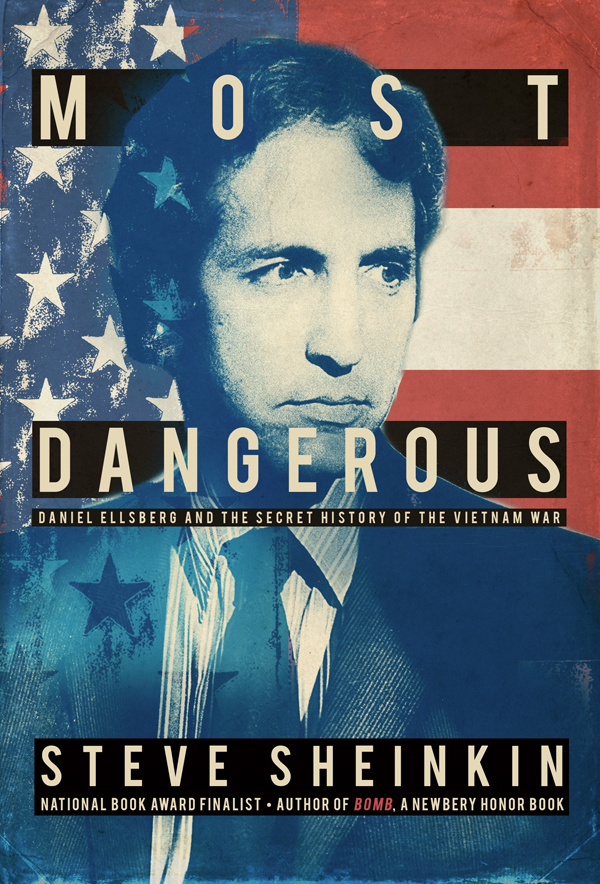Contents
Guide

The author and publisher have provided this e-book to you for your personal use only. You may not make this e-book publicly available in any way. Copyright infringement is against the law. If you believe the copy of this e-book you are reading infringes on the authors copyright, please notify the publisher at: us.macmillanusa.com/piracy.
In memory of Lynn and Jill
Daniel Ellsberg is the most dangerous man in America. He must be stopped at all costs.
Henry Kissinger
DANIEL ELLSBERGS FAMILY, FRIENDS, AND ASSOCIATES
Carol Cummings Ellsbergs first wife
Patricia (Marx) Ellsberg Ellsbergs second wife and partner in activism
Robert Ellsberg Ellsbergs son with Carol Cummings
Mary Ellsberg Ellsbergs daughter with Carol Cummings
Dr. Lewis Fielding Ellsbergs psychiatrist
Randy Kehler antiwar activist who influenced Ellsberg
Tony Russo a former colleague from the Rand Corporation and co-conspirator in copying the Pentagon Papers
Harry Rowen Ellsbergs boss at Rand
Lynda Sinay let Ellsberg and Russo use her Xerox machine to copy Pentagon Papers
John Paul Vann retired Army colonel who showed Ellsberg around Vietnam
Howard Zinn Boston University professor and antiwar activist
PRESIDENTS AND THEIR STAFFS
Harry S. Truman U.S. President from 19451953, supported Frances bid to retake Vietnam in 1945
Dwight D. Eisenhower U.S. President from 19531961, opposed elections in Vietnam in an effort to block Communists from taking power
John Fitzgerald Kennedy U.S. President from 19611963, increased the number of American troops in Vietnam from a few hundred to more than 16,000
Lyndon Baines Johnson U.S. President from 19631969
Claudia Lady Bird Johnson First Lady
Hubert Humphrey Vice President
Dean Rusk Secretary of State
Robert McNamara Secretary of Defense
John McNaughton Assistant Secretary of Defense
McGeorge Bundy National Security Advisor
Walt Rostow National Security Advisor
John McCone CIA Director
Bob Komer aide to President Johnson
Richard Nixon U.S. President from 19691974
Pat Nixon First Lady
Tricia Nixon older daughter of Richard and Pat Nixon
Julie Nixon younger daughter of Richard and Pat Nixon
Gerald Ford Nixons Vice President, 197374
Bob Haldeman Nixons White House Chief of Staff
John Mitchell Attorney General, later Nixons campaign manager
Henry Kissinger National Security Advisor, later Secretary of State
Mort Halperin National Security Council staff member
Melvin Laird Secretary of Defense
Ron Ziegler White House Press Secretary
Erwin Griswold Solicitor General
Charles Colson White House Counsel
John Dean White House Counsel
John Ehrlichman Assistant to the President for Domestic Affairs
THE PLUMBERS
Egil Krogh White House aide, head of Special Investigations Unit, also known as the Plumbers
G. Gordon Liddy formerly of the FBI
Howard Hunt formerly of the CIA
David Young of Kissingers staff
Kathy Chenow Plumbers secretary
Steve specialist with the CIAs technical services
Bernard Barker recruited by Plumbers to break into Dr. Fieldings office and the Watergate
Felipe DeDiego and Eugenio Martinez anti-communists working with Barker
James McCord former CIA technician who worked with the Plumbers
U.S. MILITARY PERSONNEL
General Earle Wheeler Chairman of the Joint Chiefs of Staff, 19641970
John McConnell Air Force Chief of Staff
General William Westmoreland Commander of U.S. military operations in Vietnam, 19641968
Admiral Ulysses Sharp Commander-in-Chief of U.S. Pacific fleet, 19631964
Captain John Herrick Commodore of the USS Maddox and Turner Joy
Commander James Stockdale pilot in the Gulf of Tonkin, prisoner of war (POW)
Lieutenant Everett Alvarez pilot, first American POW in Vietnam
Lieutenant Philip Caputo one of the first marines to fight in Vietnam, later a journalist
John McCain prisoner of war at the Hanoi Hilton, later U.S. Senator
John Kerry first Vietnam veteran to speak against the war in Congress, later presidential candidate and Secretary of State to President Barack Obama
General Victor Krulak U.S. Marines, demonstrated the flaws in General Westmorelands attrition strategy
U.S. CONGRESS
Senator Wayne Morse (D-OR), early objector to American involvement in Vietnam, cast the sole opposing vote against the Gulf of Tonkin Resolution
Senator William Fulbright (D-AR), helped steer the Gulf of Tonkin Resolution, later regretted his participation and considered releasing the Pentagon Papers
Norvil Jones, aide to Senator Fulbright
Senator Barry Goldwater (R-AZ), ran against Johnson for president in 1964
Senator Everett Dirksen (R-IL), powerful senator, friend to Lyndon Johnson
Senator George McGovern (D-SD), antiwar senator, later presidential candidate, considered taking the Pentagon Papers public
Senator Mike Gravel (D-AK), read sections of the Papers into public record
IN VIETNAM
Ho Chi Minh (Nguyen Tat Thanh) President, North Vietnam
Nguyen Van Thieu President, South Vietnam
Le Duc Tho North Vietnamese negotiator
Bui Diem South Vietnamese Ambassador to the United States
THE PRESS
The New York Times
Neil Sheehan Reporter, broke Pentagon Papers story
Abe Rosenthal Managing Editor
James Goodale General Counsel
Hedrick Smith Reporter, worked with Sheehan on Pentagon Papers
Arthur Sulzberger Publisher
Louis Loeb attorney for the New York Times
The Washington Post
Katherine Graham Publisher
Ben Bradlee Executive Editor
Ben Bagdikian Assistant Managing Editor
The Boston Globe
Thomas Winship Publisher
Tom Oliphant Reporter
CBS News
Gordon Manning Vice President
Walter Cronkite Anchor
THE COURTROOM
Matthew Byrne Presiding Judge in the case against Daniel Ellsberg
Murray Gurfein Presiding Judge in case against the New York Times
Alexander Bickel and Floyd Abrams Attorneys, defended the New York Times in Pentagon Papers case
Charlie Nesson Defense Lawyer for Daniel Ellsberg
David Nissen Chief Prosecutor in the case against Daniel Ellsberg
T HEY CAME TO CALIFORNIA TO RUIN A MAN . Not to kill him, not literally. But the next best thing.
On a summer day in 1971, two men in wigs and glasses strolled along a sunny sidewalk in Los Angeles. One had a black mustache and walked with a limp. The other carried a camera on a strap over his shoulder.
They stopped in front of a three-story building of brick and glass. The man with the mustache posed beside the entryway, smiling like a tourist while his friend snapped a series of surveillance shots. They quickly repeated the process in front of alternative entry and escape pointslow windows and the door in the back.
As they headed to their hotel, the mustached mans limp grew increasingly pronounced and by the time they reached the lobby, he was struggling to keep up. After shutting the door of their shared room, he yanked off his shoe, causing a heel-shaped hunk of lead to drop to the carpet. He pulled off his wig and glasses. The mustache stayed on; that part was real. This was G. Gordon Liddy, former agent of the Federal Bureau of Investigation.
The photographer, a retired Central Intelligence Agency agent named Howard Hunt, sat down to take notes. All that remained was to visit the target building under operating conditions. That is, at night.


